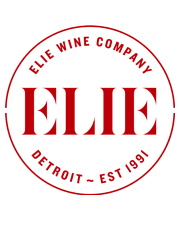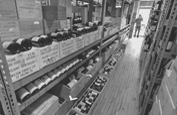A Lively, Graceful Red Wine from the Soaring Slopes of Ribeira Sacra in Western Spain
Sílice Viticultores “Sílice” (Galicia 2015)
~$26/bottle
It has long been recognized that the western Spanish region of Ribeira Sacra in Galicia had the potential to create world-class wines. Indeed, thousands of years ago, Romans carved terraces on the steep slopes that rise from the rivers below, well aware that their monumental effort in cultivating vines on these mountainsides would lead to wines of distinction. But it wasn’t until relatively recently that more than a few winemakers were producing anything other than everyday wine for local consumption.
Staring up these vineyard cliffs one might imagine they were in the famous Northern Rhône appellation of Côte-Rôtie. Perhaps that is why today’s Ribeira Sacra is a region where young winemakers are settling in to harness these soaring slopes for the purpose of making great wines.
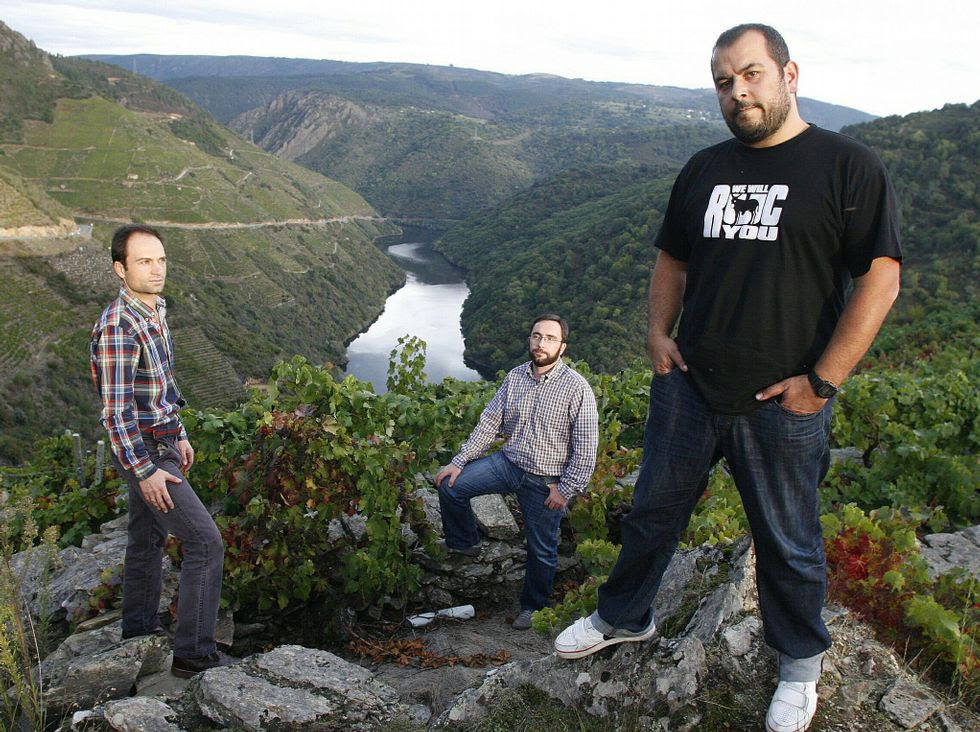 Sílice Viticultores is a small project started in 2013 by brothers Carlos and Juan Rodríguez with star winemaker Fredi Torres, a native of Galicia who cut his teeth in Priorat working with Clos Mogador before starting his own operation Saó del Coster. Production is tiny, starting out with a mere 3,800 bottles in their first year. Although the partners do not seek the Ribeira Sacra appellation status for their wines, choosing the freedom to make their own rules, they cultivate indigenous vines using organic and biodynamic methods with the goal of expressing the terroir of Amandi — one of the five subzones of Ribeira Sacra.
Sílice Viticultores is a small project started in 2013 by brothers Carlos and Juan Rodríguez with star winemaker Fredi Torres, a native of Galicia who cut his teeth in Priorat working with Clos Mogador before starting his own operation Saó del Coster. Production is tiny, starting out with a mere 3,800 bottles in their first year. Although the partners do not seek the Ribeira Sacra appellation status for their wines, choosing the freedom to make their own rules, they cultivate indigenous vines using organic and biodynamic methods with the goal of expressing the terroir of Amandi — one of the five subzones of Ribeira Sacra.
These are are lively, graceful, cool-climate wines, defined as much by the nearby Atlantic coast as the soils and slopes, with the same sort of aromatic headiness and elegant body that draws people to Burgundy and Barolo. 2015 cuvée Sílice is aimed at being an accessible red showcasing the landscape of Amandi. It’s a blend of 80% Mencía, 5% Garnacha Tintorera, 5% Albarello, 5% Merenzao, and 5% Godello. The grapes are hand-harvested (there is no alternative in these vertical vineyards) and vinified using indigenous yeasts. The wine is matured in a 17-year-old, 4,000-liter oak foudre they purchased in Châteauneuf-du-Pape. Only 1,020 cases of the 2015 vintage was produced.
The result is a wine of ripeness, concentration, and balance, with aromas of juicy wild forest berries, sweet cherries, wanton flowers, smoked tea, and loamy earth. The food culture of inland Galicia revolves around pork rather than the seafood that highlights the coastal zones. It’s easy to see a bottle of Sílice paired with a rich Galician caldo of shredded pork, chorizo, white beans, and greens.
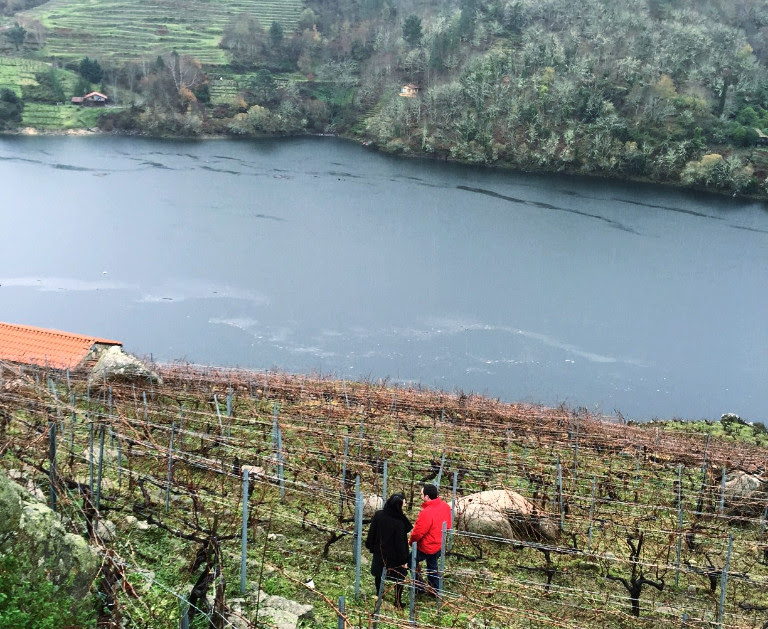
- - -
Posted on 2016.10.19 in Saturday Sips Wines, Spain DO, Ribeira Sacra | Read more...
Serious and Seriously Drinkable Old Vine Carignan from Southern France
Domaine d’Aupilhac “Le Carignan” (Mont Baudile IGP 2014) Red
Special Price: $189/6-pack (~$31/bottle)
 Formerly the most widely planted grape in France, and quite often overproduced, Carignan doesn’t have the best reputation. Generally, it’s high levels of tannins and acidity work best as a small proportion of a blend. But gifted vigneron like Sylvain Fadat know that very old Carignan vines that are managed artfully are capable of producing the concentrated ripe fruit needed for a wine of great significance. From the beginning, Sylvain has tirelessly defended Carignan as the “origin, history, and essence of the region.” So much so that he has declassified “Le Carignan” from the Languedoc Montpeyroux appellation (which requires no grape variety be more than 70% of a blend) to the more general status Mont Baudile IGP, just so that he could bottle this superb fruit on its own.
Formerly the most widely planted grape in France, and quite often overproduced, Carignan doesn’t have the best reputation. Generally, it’s high levels of tannins and acidity work best as a small proportion of a blend. But gifted vigneron like Sylvain Fadat know that very old Carignan vines that are managed artfully are capable of producing the concentrated ripe fruit needed for a wine of great significance. From the beginning, Sylvain has tirelessly defended Carignan as the “origin, history, and essence of the region.” So much so that he has declassified “Le Carignan” from the Languedoc Montpeyroux appellation (which requires no grape variety be more than 70% of a blend) to the more general status Mont Baudile IGP, just so that he could bottle this superb fruit on its own.
The 44 acre lieu-dit known as Aupilhac is a renowned, European certified organic property located in the enclave of Montpeyroux. Though five generations of Fadats have farmed these choice vineyards, it was Sylvain that brought the estate its acclaim. Not one to shy away from hard work, Sylvain cultivates vines on steep, extremely rocky terrain, and has even terraced much of the land himself. This is an enormous financial investment and back-breaking work but necessary in this case to reveal a great terroir.
Sylvain believes that effort in the vineyard has the most influence on the quality of his wine. At around 1,200 feet elevation and with southwest sun exposure, he coaxes old vines to root deep into soils of limestone, clay, scree, and blue marl. These are soils also rich in prehistoric oyster fossil deposits, which lend an incredible length and minerality to his wines.
“Le Carignan” is 100% Carignan from vineyards situated on these hillside terraces. The low yielding vines are over 60-years old. The grapes are harvested by hand, de-stemmed, and only indigenous yeasts are used. After barrel aging for 20 months, the wines are bottled unfiltered in accordance with the lunar cycle and optimal atmospheric pressure.
The result is a wine of concentrated dark fruit that’s never heavy on the palate, with ripe tannins on the finish and a final twist of freshness at the close. Above the elegant textures are a grocery basket of sumptuous aromatics: blueberry and red currants, moist earth, and the Languedoc shrubland (garrigue) that comes across as just the slightest hint of rosemary. While drinking beautifully now, this is a wine of longevity – reports have the 1989 vintage (Sylvain’s first) still drinking nicely. And this is one of the reasons that the Languedoc is still a region with some great values. You won’t find many wines for around $30 that can develop in the cellar for 25+ years.
A Daily Drinker from Domaine d’Aupilhac
Domaine d’Aupilhac “Lou Maset” (Coteaux du Languedoc 2015) Red
Special Price: $91/6-pack (~$15/bottle)
It stands to reason that some of the best inexpensive wines are the ones made by winemakers who know how to make great wines. With all the characteristics of a quality Languedoc wine “Lou Maset” is made in a style that emphasizes its fresh fruit. It’s an ideal bottle for those busy weeknights when dinner consists of a quick cheese platter or even pizza. A blend of 40% Grenache, 40% Cinsault, 10% Mourvèdre, and 10% Carignan, vinification is done traditionally in stainless steel vats and the wine is aged a further six months in neutral barrels.
- - -
Posted on 2016.10.12 in France, Saturday Sips Wines, Languedoc-Roussillon | Read more...
Domaine Albert Boxler – World-Class Wines, Alsace Terroir
Albert Boxler Chasselas (Alsace 2014)
$172/6-pack (~$29/bottle)
In far eastern France, on the border with southern Germany, the winemaking region of Alsace is perhaps the most geologically complex in all of France. Much like Burgundy, the vineyards of Alsace lie on the western side of an escarpment that holds a mosaic of soil types and microclimates. A range of east-facing hillsides, sunny days, and protection from moisture by the Vosges Mountains make for an ideal environment for vine growing. Unlike Burgundy, the wines of Alsace are known more by grape variety than vineyard name, making it a bit more difficult to presume quality based on a label alone.
At Elie Wine Co. we’re taking that kind of guesswork out of the equation by bringing in only the best producers of their regions – like Domaine Albert Boxler.
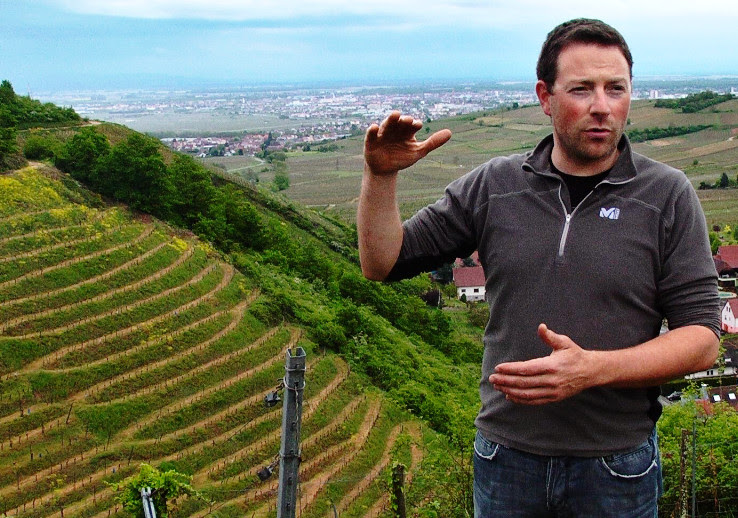 The Boxler family arrived in Alsace from Switzerland in the late 17th Century but only began estate bottling in the 1940s. The wine still wears a label drawn by Albert Boxler’s cousin in 1946. Today it is Jean Boxler, grandson to Albert, that manages the family’s holdings of around 34 acres centered around the ancient village of Niedermorschwihr in the most renowned sub-zone of Alsace, Haut-Rhin. The imposing granite hillside of the Grand Cru “Sommerberg” terminates in Jean’s driveway allowing him to basically live in the vineyards and utilize organic cultivation techniques to ensure exceptionally healthy fruit year after year. Jean also owns land in the powerful Grand Cru of “Brand” just across from “Sommerberg” and near the village of Turckheim.
The Boxler family arrived in Alsace from Switzerland in the late 17th Century but only began estate bottling in the 1940s. The wine still wears a label drawn by Albert Boxler’s cousin in 1946. Today it is Jean Boxler, grandson to Albert, that manages the family’s holdings of around 34 acres centered around the ancient village of Niedermorschwihr in the most renowned sub-zone of Alsace, Haut-Rhin. The imposing granite hillside of the Grand Cru “Sommerberg” terminates in Jean’s driveway allowing him to basically live in the vineyards and utilize organic cultivation techniques to ensure exceptionally healthy fruit year after year. Jean also owns land in the powerful Grand Cru of “Brand” just across from “Sommerberg” and near the village of Turckheim.
All grapes are handpicked and sorted. After harvest, the wines are vinified using indigenous yeasts and aged in old foudres in a small cellar underneath the family home until bottling. He keeps all of his wines on the lees with no racking until bottling 11 months after the harvest.
Only in years when Jean believes the variety is at its most interesting does he realize his Swiss roots with Chasselas, a grape variety of Swiss origin. The Chasselas vines are over 45 years old and growing out of granite soils. It’s a wine that exudes its Alpine essence with aromas of grassy meadows, tiny white flowers and raw hazelnut. A sip is dense and bracing and filled with just ripe stone fruit. This wine begs to be paired with a traditional Raclette feast.
The Réserve Wines of Domaine Albert Boxler
Riesling Réserve – $65/bottle
Sourced primarily from 15 year old vines from a plot in the Grand Cru of Sommerberg. Full and almost lush on the palate. Drink now or develop in a proper cellar over the next 15 years.
Pinot Gris Réserve – $55/bottle
15-65 year old vines from the Grand Crus of Sommerberg and Brand. Rich, and dense with flavors of honeyed peach and herbs. Drink now or develop in the cellar over the next 8 years.
Pinot Blanc Réserve – $45/bottle
40 year old vines from the Kirchberg section of the Grand Cru of Brand. Precise white fruit and floral aromatics intertwined with intensity and depth. Drink now or develop in the cellar over the next 10 years.
Gewurztraminer Réserve – $55/bottle
40-67 year old vines from the limestone terroir of Heimbourg and Pfoeller vineyards. Fresh pineapple and floral aromas lead to a an elegant palate with a lingering salinity. Drink now or develop in the cellar over the next 15 years.
- - -
Posted on 2016.10.05 in France, Saturday Sips Wines, Alsace | Read more...
The Champagne Society – October 2016 Selection: Champagne Billecart-Salmon
Champagne Billecart-Salmon Cuvée “Sous Bois” Brut
 Cuvée “Sous Bois” is a relatively new bottling for the renowned Champagne house of Billecart-Salmon. Unique to their lineup, “Sous Bois” literally means “under wood” and was inspired by the oak-fermented parcels of their top cuvées. It’s aspiration is to uphold the Billecart-Salmon mandate of freshness and elegance.
Cuvée “Sous Bois” is a relatively new bottling for the renowned Champagne house of Billecart-Salmon. Unique to their lineup, “Sous Bois” literally means “under wood” and was inspired by the oak-fermented parcels of their top cuvées. It’s aspiration is to uphold the Billecart-Salmon mandate of freshness and elegance.
The “wood” in use here are older barriques from Burgundy between the ages of five to fifteen years so that the Cuvée “Sous Bois” resounds with the classic Billecart precision yet displays a certain richness that only barrel fermentation and aging can achieve. The blend is one-third each of the three Champagne grapes, Pinot Meunier, Pinot Noir, and Chardonnay, from Grand Cru and Premier Cru sites, mainly from the 2007 vintage but including reserve wines from the previous vintages. It was then aged in bottle for five years prior to release. There is only six grams per liter of dosage, on the very low end of Brut.
The result is a Champagne redolent of orchard fruits, lemon curd, freshly-baked pie crust, toasted anise, and a pleasant wisp of smoldering earth. A superb richness is immediately balanced by a grippy acidity that uncoils long throughout a sip.
Founded in 1818 and now managed by sixth generation Antoine Roland-Billecart, Billecart-Salmon has been a small, family-owned Champagne house based in the village of Mareuil-sur-Aÿ, near Epernay. The elegant delicacy of their entire range of wines is due to a house philosophy of respecting the integrity of the fruit through the entire process of winemaking and a production regime that is geared toward capturing every nuance of the fruit. Whether sourcing fruit from their own estate holdings or other growers the concept is the same: meticulous care of the vines, scrupulous selection, low dosage, and long aging. Theirs are Champagnes of crystal-clear fidelity.

- - -
Posted on 2016.10.03 in France, The Champagne Society, Champagne | Read more...
Old Vine Gamay from a Rising Star in Beaujolais
Charly Thévenet “Grain & Granit” (Régnié, 2014)
$156/6-pack (~$26/bottle)
Young Charly Thévenet cut his teeth working at his family’s small, 12 acre estate in the Beaujolais Cru of Morgon. While many winemakers get their start by studying beneath their parents, Charly had a bit of an advantage. His father is none other than Jean-Paul Thévenet. In the 1980s, Jean-Paul, along with local vignerons Marcel Lapierre, Guy Breton, and Jean Foillard, called for a return to the old practices of viticulture and vinification, revolting against the glut of mass-produced and over-commercialized wine that was coming out of Beaujolais at the time.
Their philosophy starts with maintaining naturally lower yielding old vines. Synthetic herbicides and pesticides are never used. Harvests are later in the season and are rigorously sorted to remove all but the healthiest grapes. Fermentation and bottling are done with minimal doses of sulfur dioxide and no filtration. These are techniques that allow terroir, or the sense of place in the wine, to express itself naturally, without the ornamentation of novel cellar procedures.
 Charly has assumed the mantle of traditional vigneron in his own 7.5 acre parcel of near eighty-year-old Gamay vines in the Cru of Régnié, situated on a plateau of seabed stone neighboring his father’s vineyards. To complement the philosophy learned from his father, he uses biodynamic farming techniques in the vineyard. The wine is fermented only with indigenous yeasts and then aged in four-year-old Burgundian barriques.
Charly has assumed the mantle of traditional vigneron in his own 7.5 acre parcel of near eighty-year-old Gamay vines in the Cru of Régnié, situated on a plateau of seabed stone neighboring his father’s vineyards. To complement the philosophy learned from his father, he uses biodynamic farming techniques in the vineyard. The wine is fermented only with indigenous yeasts and then aged in four-year-old Burgundian barriques.
Only 525 cases produced, “Grain & Granit” is the essence of serious and seriously drinkable Cru Beaujolais. The summer of 2014 was cooler and wetter than normal but sunny days and cool nights prevailed toward the end of August and into early September. The harvested fruit was perfectly ripe, with thick skins and ideal acidity. For the best producers, this translates to wines that clearly show their Burgundy pedigree.
High-toned violet, raspberry, and cherry licorice aromatics precede a sip that is sublimely balanced between firm, fresh fruit and mineral structure. With the warm weather rolling in this week the wine has us thinking spring and the start of outdoor gatherings with friends. Drink just slightly chilled and pair with scrambled eggs and morel mushrooms or a simple baked chicken with a salad of new, tender greens.
- - -
Posted on 2016.09.28 in France, Saturday Sips Wines, Beaujolais | Read more...
Featured Wines
- Notebook: A’Boudt Town
- Saturday Sips Wines
- Saturday Sips Review Club
- The Champagne Society
- Wine-Aid Packages
Wine Regions
Grape Varieties
Aglianico, Albarín Blanco, Albillo, Aleatico, Alicante Bouschet, Altesse, Arcos, Aubun, Auxerrois, barbera, Beaune, Bonarda, Cabernet Franc, Cabernet Sauvignon, Caino, Caladoc, Carcajolu-Neru, Carignan, Chablis, Chardonnay, Chasselas, Chenin Blanc, Cinsault, Cortese, Corvina, Corvinone, Cot, Erbamat, Ferrol, Fiano, folle Blanche, Frappato, Friulano, Fromenteau, Fumin, Garganega, Garnacha, Gewurztraminer, Godello, Grenache, Grolleau, Jacquère, Lambrusco, Lladoner Pelut, Loureira, Macabeo, Macabou, Maconnais, Malvasia, Malvasia Nera, manseng, Marsanne, Melon de Bourgogne, Mencía, Merlot, Mondeuse, Montanaccia, Montepulciano, Morescola, Morescono, Moscatell, Mourv, Mourvèdre, Muscadelle, Nebbiolo, Nero d'Avola, Palomino, Parellada, Pecorino, Persan, Petit Meslier, Petit Verdot, Pinot Auxerrois, Pinot Blanc, Pinot Meunier, Pinot Noir, Poulsard, Prieto Picudo, Rondinella, Rose, Roussanne, Sangiovese, Sauvignon Blanc, Savignin, Semillon, Souson, Sparkling, Sylvaner, Syrah, Tannat, Teroldego, Timorasso, Trebbiano, Treixadura, trepat, Trousseau, vaccarèse, Verdicchio, Viognier, ViuraWines & Events by Date
- September 2025
- August 2025
- July 2025
- June 2025
- May 2025
- April 2025
- March 2025
- February 2025
- January 2025
- December 2024
- November 2024
- October 2024
- September 2024
- August 2024
- July 2024
- June 2024
- May 2024
- April 2024
- March 2024
- February 2024
- January 2024
- December 2023
- November 2023
- October 2023
- September 2023
- August 2023
- July 2023
- June 2023
- May 2023
- April 2023
- March 2023
- February 2023
- January 2023
- December 2022
- November 2022
- October 2022
- September 2022
- August 2022
- July 2022
- June 2022
- May 2022
- April 2022
- March 2022
- February 2022
- January 2022
- December 2021
- November 2021
- October 2021
- September 2021
- August 2021
- July 2021
- June 2021
- May 2021
- April 2021
- March 2021
- February 2021
- January 2021
- December 2020
- November 2020
- October 2020
- September 2020
- August 2020
- July 2020
- June 2020
- May 2020
- April 2020
- March 2020
- February 2020
- January 2020
- December 2019
- November 2019
- October 2019
- September 2019
- August 2019
- July 2019
- June 2019
- May 2019
- April 2019
- March 2019
- February 2019
- January 2019
- December 2018
- November 2018
- October 2018
- September 2018
- August 2018
- July 2018
- June 2018
- May 2018
- April 2018
- March 2018
- February 2018
- January 2018
- December 2017
- November 2017
- October 2017
- September 2017
- August 2017
- July 2017
- June 2017
- May 2017
- April 2017
- March 2017
- February 2017
- January 2017
- December 2016
- November 2016
- October 2016
- September 2016
- August 2016
- July 2016
- June 2016
- May 2016
- April 2016
- March 2016
- February 2016
- January 2016
- December 2015
- November 2015
- October 2015
- September 2015
- August 2015
- July 2015
- June 2015
- May 2015
- April 2015
- March 2015
- February 2015
- January 2015
- December 2014
- November 2014
- October 2014
- September 2014
- August 2014
- July 2014
- June 2014
- April 2014
- March 2014
- February 2014
- January 2014
- December 2013
- November 2013
- October 2013
- September 2013
- August 2013
- July 2013
- June 2013
- May 2013
- April 2013
- March 2013
- February 2013
- January 2013
- December 2012
- November 2012
- October 2012

